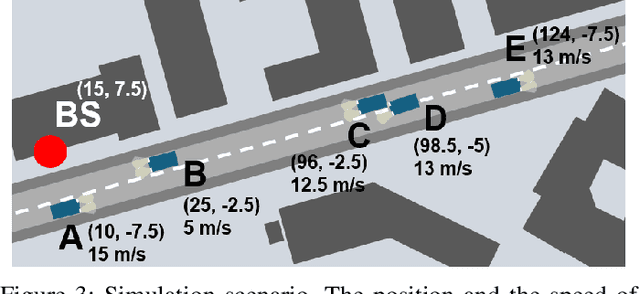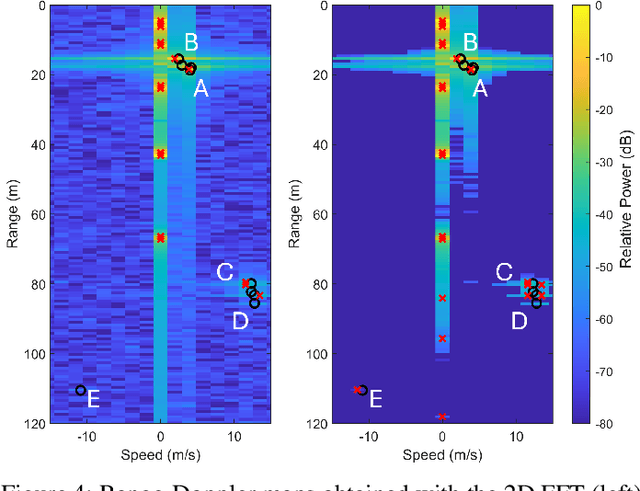Marina Petrova
Cross-Environment Transfer Learning for Location-Aided Beam Prediction in 5G and Beyond Millimeter-Wave Networks
Mar 18, 2025Abstract:Millimeter-wave (mm-wave) communications requirebeamforming and consequent precise beam alignmentbetween the gNodeB (gNB) and the user equipment (UE) toovercome high propagation losses. This beam alignment needs tobe constantly updated for different UE locations based on beamsweepingradio frequency measurements, leading to significantbeam management overhead. One potential solution involvesusing machine learning (ML) beam prediction algorithms thatleverage UE position information to select the serving beamwithout the overhead of beam sweeping. However, the highlysite-specific nature of mm-wave propagation means that MLmodels require training from scratch for each scenario, whichis inefficient in practice. In this paper, we propose a robustcross-environment transfer learning solution for location-aidedbeam prediction, whereby the ML model trained on a referencegNB is transferred to a target gNB by fine-tuning with a limiteddataset. Extensive simulation results based on ray-tracing in twourban environments show the effectiveness of our solution forboth inter- and intra-city model transfer. Our results show thatby training the model on a reference gNB and transferring themodel by fine-tuning with only 5% of the target gNB dataset,we can achieve 80% accuracy in predicting the best beamfor the target gNB. Importantly, our approach improves thepoor generalization accuracy of transferring the model to newenvironments without fine-tuning by around 75 percentage points.This demonstrates that transfer learning enables high predictionaccuracy while reducing the computational and training datasetcollection burden of ML-based beam prediction, making itpractical for 5G-and-beyond deployments.
Near-Optimal Cell-Free Beamforming for Physical Layer Multigroup Multicasting
Dec 18, 2024



Abstract:Physical layer multicasting is an efficient transmission technique that exploits the beamforming potential at the transmitting nodes and the broadcast nature of the wireless channel, together with the demand for the same content from several UEs. This paper addresses the max-min fair multigroup multicast beamforming optimization, which is an NP-hard problem. We propose a novel iterative elimination procedure coupled with semidefinite relaxation (SDR) to find the near-global optimum rank-1 beamforming vectors in a cell-free massive MIMO (multiple-input multiple-output) network setup. The proposed optimization procedure shows significant improvements in computational complexity and spectral efficiency performance compared to the SDR followed by the commonly used randomization procedure and the state-of-the-art difference-of-convex approximation algorithm. The significance of the proposed procedure is that it can be utilized as a rank reduction method for any problem in conjunction with SDR.
Optimal Weight Scheme for Fusion-Assisted Cooperative Multi-Monostatic Object Localization in 6G Networks
Aug 29, 2024Abstract:Cooperative multi-monostatic sensing enables accurate positioning of passive targets by combining the sensed environment of multiple base stations (BS). In this work, we propose a novel fusion algorithm that optimally finds the weight to combine the time-of-arrival (ToA) and angle-of-arrival (AoA) likelihood probability density function (PDF) of multiple BSs. In particular, we employ a log-linear pooling function that fuses all BSs' PDFs using a weighted geometric average. We formulated an optimization problem that minimizes the Reverse Kullback Leibler Divergence (RKLD) and proposed an iterative algorithm based on the Monte Carlo importance sampling (MCIS) approach to obtain the optimal fusion weights. Numerical results verify that our proposed fusion scheme with optimal weights outperforms the existing benchmark in terms of positioning accuracy in both unbiased (line-of-sight only) and biased (multipath-rich environment) scenarios.
Wireless MAC Protocol Synthesis and Optimization with Multi-Agent Distributed Reinforcement Learning
Aug 19, 2024Abstract:In this letter, we propose a novel Multi-Agent Deep Reinforcement Learning (MADRL) framework for Medium Access Control (MAC) protocol design. Unlike centralized approaches, which rely on a single entity for decision-making, MADRL empowers individual network nodes to autonomously learn and optimize their MAC based on local observations. Leveraging ns3-ai and RLlib, as far as we are aware of, our framework is the first of a kind that enables distributed multi-agent learning within the ns-3 environment, facilitating the design and synthesis of adaptive MAC protocols tailored to specific environmental conditions. We demonstrate the effectiveness of the MADRL MAC framework through extensive simulations, showcasing superior performance compared to legacy protocols across diverse scenarios. Our findings highlight the potential of MADRL-based MAC protocols to significantly enhance Quality of Service (QoS) requirements for future wireless applications.
Empowering 5G PRS-Based ISAC with Compressed Sensing
Jul 18, 2024



Abstract:To enable widespread use of Integrated Sensing and Communication (ISAC) in future communication systems, an important requirement is the ease of integration. A possible way to achieve this is to use existing communication reference signals for sensing, such as the 5G Positioning Reference Signal (PRS). Existing works have demonstrated promising results by using the PRS with classical signal processing techniques. However, this approach suffers from a loss of SNR due to the sparse resource allocation. In this work, we improve upon existing results by combining the 5G PRS with compressed sensing methods. We demonstrate that our method achieves better noise robustness compared to the existing works and has superresolution properties, making it an ideal choice for range-Doppler map generation and target detection even in noisy environments.
Unknown Interference Modeling for Rate Adaptation in Cell-Free Massive MIMO Networks
Apr 18, 2024



Abstract:Co-channel interference poses a challenge in any wireless communication network where the time-frequency resources are reused over different geographical areas. The interference is particularly diverse in cell-free massive multiple-input multiple-output (MIMO) networks, where a large number of user equipments (UEs) are multiplexed by a multitude of access points (APs) on the same time-frequency resources. For realistic and scalable network operation, only the interference from UEs belonging to the same serving cluster of APs can be estimated in real-time and suppressed by precoding/combining. As a result, the unknown interference arising from scheduling variations in neighboring clusters makes the rate adaptation hard and can lead to outages. This paper aims to model the unknown interference power in the uplink of a cell-free massive MIMO network. The results show that the proposed method effectively describes the distribution of the unknown interference power and provides a tool for rate adaptation with guaranteed target outage.
HBF MU-MIMO with Interference-Aware Beam Pair Link Allocation for Beyond-5G mm-Wave Networks
Feb 27, 2024



Abstract:Hybrid beamforming (HBF) multi-user multiple-input multiple-output (MU-MIMO) is a key technology for unlocking the directional millimeter-wave (mm-wave) nature for spatial multiplexing beyond current codebook-based 5G-NR networks. In order to suppress co-scheduled users' interference, HBF MU-MIMO is predicated on having sufficient radio frequency chains and accurate channel state information (CSI), which can otherwise lead to performance losses due to imperfect interference cancellation. In this work, we propose IABA, a 5G-NR standard-compliant beam pair link (BPL) allocation scheme for mitigating spatial interference in practical HBF MU-MIMO networks. IABA solves the network sum throughput optimization via either a distributed or a centralized BPL allocation using dedicated CSI reference signals for candidate BPL monitoring. We present a comprehensive study of practical multi-cell mm-wave networks and demonstrate that HBF MU-MIMO without interference-aware BPL allocation experiences strong residual interference which limits the achievable network performance. Our results show that IABA offers significant performance gains over the default interference-agnostic 5G-NR BPL allocation, and even allows HBF MU-MIMO to outperform the fully digital MU-MIMO baseline, by facilitating allocation of secondary BPLs other than the strongest BPL found during initial access. We further demonstrate the scalability of IABA with increased gNB antennas and densification for beyond-5G mm-wave networks.
Power Allocation Scheme for Device-Free Localization in 6G ISAC Networks
Feb 16, 2024Abstract:Integrated Sensing and Communication (ISAC) is considered one of the crucial technologies in the upcoming sixth-generation (6G) mobile communication systems that could facilitate ultra-precise positioning of passive and active targets and extremely high data rates through spectrum coexistence and hardware sharing. Such an ISAC network offers a lot of benefits, but comes with the challenge of managing the mutual interference between the sensing and communication services. In this paper, we investigate the problem of localization accuracy in a monostatic ISAC network under consideration of inter-BS interference due to communication signal and sensing echoes, and self-interference at the respective BS. We propose a power allocation algorithm that minimizes BS's maximum range estimate error while considering minimum communication signal-to-interference-plus-noise ratio (SINR) and total power constraint. Our numerical results demonstrate the effectiveness of the proposed algorithm and indicate that it can enhance the sensing performance when the self-interference is effectively suppressed.
Cooperative Multi-Monostatic Sensing for Object Localization in 6G Networks
Nov 24, 2023Abstract:Enabling passive sensing of the environment using cellular base stations (BSs) will be one of the disruptive features of the sixth-generation (6G) networks. However, accurate localization and positioning of objects are challenging to achieve as multipath significantly degrades the reflected echos. Existing localization techniques perform well under the assumption of large bandwidth available but perform poorly in bandwidth-limited scenarios. To alleviate this problem, in this work, we introduce a 5G New Radio (NR)-based cooperative multi-monostatic sensing framework for passive target localization that operates in the Frequency Range 1 (FR1) band. We propose a novel fusion-based estimation process that can mitigate the effect of multipath by assigning appropriate weight to the range estimation of each BS. Extensive simulation results using ray-tracing demonstrate the efficacy of the proposed multi-sensing framework in bandwidth-limited scenarios.
Communication-Efficient Orchestrations for URLLC Service via Hierarchical Reinforcement Learning
Jul 25, 2023Abstract:Ultra-reliable low latency communications (URLLC) service is envisioned to enable use cases with strict reliability and latency requirements in 5G. One approach for enabling URLLC services is to leverage Reinforcement Learning (RL) to efficiently allocate wireless resources. However, with conventional RL methods, the decision variables (though being deployed at various network layers) are typically optimized in the same control loop, leading to significant practical limitations on the control loop's delay as well as excessive signaling and energy consumption. In this paper, we propose a multi-agent Hierarchical RL (HRL) framework that enables the implementation of multi-level policies with different control loop timescales. Agents with faster control loops are deployed closer to the base station, while the ones with slower control loops are at the edge or closer to the core network providing high-level guidelines for low-level actions. On a use case from the prior art, with our HRL framework, we optimized the maximum number of retransmissions and transmission power of industrial devices. Our extensive simulation results on the factory automation scenario show that the HRL framework achieves better performance as the baseline single-agent RL method, with significantly less overhead of signal transmissions and delay compared to the one-agent RL methods.
 Add to Chrome
Add to Chrome Add to Firefox
Add to Firefox Add to Edge
Add to Edge